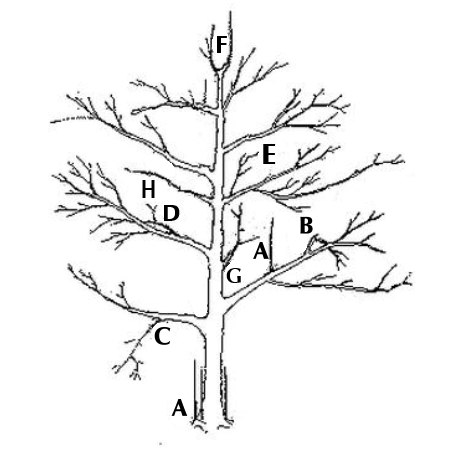Pruning Young Fruit Trees
To produce quality fruit, fruit trees such as apples, pears, cherries and plums need regular pruning in their first few years to develop healthy growth and well-spaced branches, and continuous minor pruning there-after. There are many different ways to prune fruit trees that result in good quality trees such as central leader, multi leader, open center, espalier and cordon styles, and we recommend that you research other methods if you are interested. This is an overview of central leader training, which results in an attractive fruit tree for ornamental home use.
It is important to be willing to sacrifice maximum fruit production for the first few years in order to establish the proper form for your fruit tree. This will insure greater fruit production in future years.
A tree pruned to central leader will have a somewhat Christmas-tree shape at maturity, with layers of the lower branches longer than the upper branches, and terminating in a single leader at the top. Each layer of branches should have 3 or 4 branches that radiate from the trunk fairly evenly, not directly across from or above one another. The next layer of branches should start 18 to 24 inches above the one below to allow for light to penetrate to the interior. The layers of branches alternating with open spaces continue up to the desired height of the tree. To create this shape requires careful pruning for the first several years.
What to Prune
When pruning Fruit trees, the following types of growth should be removed:
A. Watersprouts and suckers
B. Broken branches or stubs
C. Branches that grow downward
D. Crossing over or rubbing branches (remove the weaker branch)
E. Shaded or interior branches
F. Competing leaders
G. Long slender growth in the inner part of the tree
H. Whorls (branches on the exact same plane as another branch)
Apples - Fruits are usually borne from fruit buds on short spurs two years old or older. Spurs may live 15-20 years and tend to bear fruit every other year. When fruit sets, new growth comes from the side of the spur causing it to develop a zigzag growth pattern. Non fruiting spurs are straight. When pruning, be careful not to remove fruiting spurs.
Pears - Trees are pruned similar to apples but tend to be more upright growing. Branch spreaders are a good method of developing wider crotch angles. Pears are slow to began fruiting and produce their fruits on spurs.
Plums - Bear the majority of their fruit on vigorous spurs on wood two years or more old. Avoid heavy pruning which stimulates watersprout growth. A light thinning out of small branches and twigs is needed each year to open up the tree and prevent declining fruit production in the inner area of the tree. Older tree which haven't been properly pruned bear fruit only on the outer 2-3 feet of each branch.
Apricots - Most of the fruit is produced on short spurs which are productive for up to three years. Annual thinning-out of upper branches is needed prevent inner shading and to stimulate the development of new fruiting spurs.
Sour Cherries - Produce some fruit on annual shoots but most is borne on spurs. Light thinning out of upper branches is needed to keep the tree open and to allow for good sun penetration.
When to prune
Trees pruned heavily in winter respond in spring with many vigorous shoots called water sprouts, identifiable by their distinctly straight-up growth. These are undesirable and will need to be re-moved, causing a cycle of heavy pruning and vigorous re-growth. Heavy winter pruning can also lead to excessive vegetative growth that can reduce fruit development. Winter pruning should be restricted to light pruning and removal of diseased or broken branches.
When winter pruning, prune as late in winter as possible to avoid winter damage. Apple and pecan trees should be pruned first, followed by cherry, peach, and plum trees.
Summer pruning removes energy-producing portions of the tree and can reduce tree growth. Summer pruning should be limited to removing the upright and vigorous current season's growth using thinning cuts. Summer pruning can be started as soon as buds begin to grow, though it’s usually best to wait until new growth is several inches long. This is particularly true with young trees, which are more easily damaged by late cold snaps. To minimize the potential for winter injury, summer pruning should not be done after mid-August.
On older trees where renovation is necessary, the major branch removal should be staggered over the course of two years.
Fruit thinning
Top: Branch with unthinned fuit
Bottom: Fruit thinned
While it’s tempting to try to keep every fruit that sets on your tree, it is important to remove some for several reasons. First, it allows the remaining fruit to grow to optimum size and quality. Second, it increases the ability of the tree to form flower buds (and fruit) the following year. Third, allowing more fruit to develop than branches can support can lead to deformation or break-age of the branches, especially in younger fruit trees with still-flexible branches. Note that cherries do not need to be thinned.
To thin, simply remove fruit when it’s approximately ½” in diameter, leaving one fruit every 6 to 10 inches. Cut rather than pull the fruit off, as you do not want to damage the fruit-producing spur.


